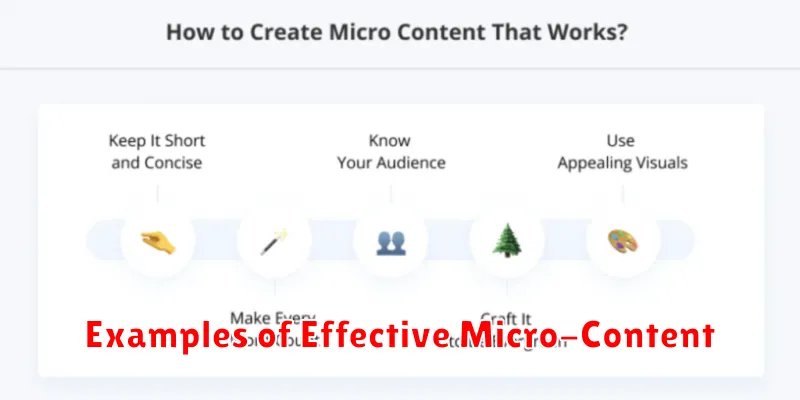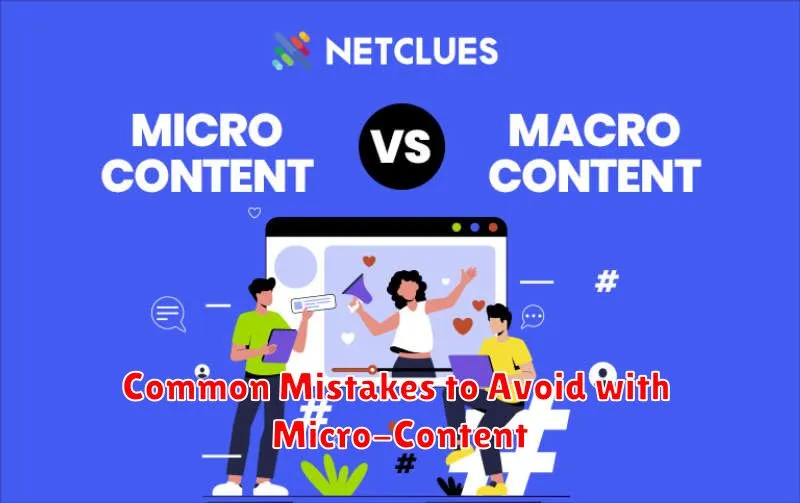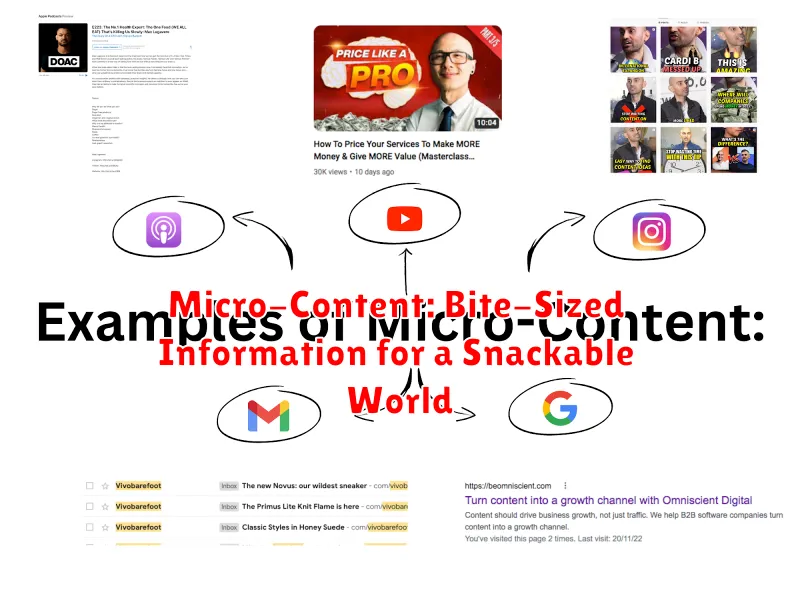In today’s fast-paced digital landscape, where information overload is the norm, capturing and retaining audience attention is more challenging than ever. Micro-content has emerged as a powerful solution, delivering bite-sized information in a readily consumable format. This approach caters to shrinking attention spans and the increasing demand for quick, easily digestible content. From concise social media posts to short videos and infographics, micro-content provides snackable information that fits seamlessly into our busy lives. Understanding how to effectively create and utilize micro-content is crucial for engaging audiences and achieving communication goals in this snackable world.
This article explores the multifaceted world of micro-content, examining its various forms, benefits, and best practices for implementation. We will delve into the strategies for crafting compelling bite-sized information that resonates with your target audience and drives engagement. Discover how micro-content can enhance your content marketing strategy, boost social media presence, and ultimately, help you thrive in a snackable world where concise and impactful communication reigns supreme. Learn how to optimize your content for maximum impact and effectively leverage the power of micro-content to connect with your audience in meaningful ways.
What is Micro-Content?
Micro-content refers to small, concise pieces of information designed for easy consumption and quick understanding. It’s characterized by its brevity and focus on a single idea or concept. Think of it as bite-sized information perfectly suited for today’s fast-paced digital world.
Often delivered in short sentences, bullet points, or lists, micro-content is easily digestible and shareable. Its purpose is to provide immediate value and answer specific questions quickly, without requiring a significant time investment from the audience.
Different from longer-form content like blog posts or articles, micro-content thrives on its ability to convey a message efficiently. It’s the quick snack compared to a full meal, providing just enough sustenance to satisfy an immediate informational need.
Why is Micro-Content Important?
In today’s fast-paced digital landscape, capturing and retaining audience attention is more challenging than ever. People are constantly bombarded with information, leading to shorter attention spans and a preference for easily digestible content. This is where micro-content becomes crucial.
Micro-content’s concise nature allows it to effectively cut through the noise. It delivers key information quickly, respecting the audience’s time and catering to their desire for immediate gratification. This quick delivery increases the likelihood of engagement and message retention.
Furthermore, micro-content is highly shareable. Its compact format makes it ideal for dissemination across various social media platforms, expanding reach and brand visibility. This shareability contributes to increased brand awareness and potential viral marketing.
Finally, micro-content aligns perfectly with mobile consumption. With the majority of internet access occurring on mobile devices, content that is easily viewed and interacted with on smaller screens is essential for successful communication. Its adaptability to mobile platforms ensures accessibility for a wider audience.
Benefits of Using Micro-Content
Leveraging micro-content offers numerous advantages for both businesses and consumers. Its concise nature makes it easily digestible, allowing audiences to quickly grasp key information without a significant time investment. This contributes to improved content engagement and knowledge retention.
Micro-content is inherently shareable due to its compact format. This characteristic increases the likelihood of content going viral, expanding brand reach and visibility across various platforms. It also supports multi-platform compatibility, adapting seamlessly to diverse social media channels and mobile devices.
From a business perspective, micro-content is cost-effective to produce, requiring fewer resources compared to longer-form content. It’s also highly adaptable, allowing for easy repurposing and integration into different marketing strategies. This flexibility contributes to increased content ROI and improved overall marketing effectiveness.
Examples of Effective Micro-Content

Social Media Posts: A short tweet highlighting a key statistic from a recent report, an Instagram story showcasing a new product feature, or a Facebook post with a quick tip related to your industry. These bite-sized pieces of information are easily digestible and shareable.
Short Videos: Explainer videos under 60 seconds demonstrating how to use a product, testimonials from satisfied customers, or quick animations summarizing complex concepts. These visuals capture attention and deliver information efficiently.
Infographics: Data visualization in a concise and appealing format. A small infographic highlighting key takeaways from a survey or illustrating a process can be more impactful than lengthy text.
Email Subject Lines: Compelling and concise subject lines that entice recipients to open the email. A powerful subject line can be a crucial piece of micro-content.
Website Snippets: Short, impactful headlines, calls to action, or testimonials strategically placed on a website. These snippets can guide users and encourage engagement.
How to Create Engaging Micro-Content
Creating effective micro-content requires a strategic approach. Begin by identifying your target audience and understanding their needs and preferences. What information are they seeking? What platforms do they frequent?
Next, focus on a single idea. Micro-content thrives on brevity and clarity. Distill your message down to its core component. Use strong verbs and concise language to maximize impact.
Visual appeal is crucial. Incorporate high-quality images, short videos, or animated GIFs when appropriate to capture attention and enhance understanding. Ensure visuals are relevant and complement the text.
Maintain consistency in your brand voice and messaging across all micro-content pieces. This builds brand recognition and fosters trust with your audience.
Finally, test and refine your approach. Analyze engagement metrics to understand what resonates with your audience and adjust your strategy accordingly.
Best Practices for Micro-Content Strategy
Developing a successful micro-content strategy requires careful planning and execution. Prioritize clarity and conciseness above all else. Each piece of micro-content should deliver a single, easily digestible idea.
Know your audience and tailor your content to their specific needs and interests. Consider where they are most likely to encounter your micro-content and adapt the format accordingly. A tweet will differ significantly from an Instagram story.
Maintain consistency with your brand voice and messaging. While brevity is key, ensure your micro-content still reflects your overall brand identity.
Repurpose existing content. Longer-form content can often be broken down into smaller, more manageable chunks for micro-content distribution. This maximizes the reach and impact of your existing materials.
Use strong visuals where appropriate. While not required for all formats, compelling visuals can significantly enhance engagement with your micro-content.
Measuring the Success of Your Micro-Content
Measuring the effectiveness of your micro-content strategy is crucial for continuous improvement and optimization. Key metrics provide insights into what resonates with your audience and what needs adjustment.
Engagement is a primary indicator of success. Track metrics such as likes, shares, comments, and saves. These actions demonstrate audience interest and the shareability of your content.
Reach and impressions offer insights into how many people your micro-content is reaching. Monitor these numbers to understand the visibility of your content and its potential impact.
Website traffic originating from your micro-content can indicate its effectiveness in driving users to your main platform. Track click-through rates and conversions stemming from your micro-content campaigns.
Finally, keep an eye on brand mentions and overall brand sentiment. Micro-content can significantly influence brand perception, and monitoring these aspects is crucial for long-term success.
Common Mistakes to Avoid with Micro-Content

While micro-content offers significant advantages, certain pitfalls can hinder its effectiveness. Avoiding these common mistakes is crucial for maximizing impact.
One frequent error is lack of clarity. Brevity shouldn’t come at the expense of meaning. Ensure each piece of micro-content conveys a complete thought or offers a valuable insight. Ambiguity can confuse the audience and diminish engagement.
Another mistake is inconsistent branding. Micro-content should align with your overall brand voice and style. Inconsistencies create a disjointed experience and weaken brand recognition.
Ignoring context is also detrimental. Micro-content should be relevant to the platform and the audience’s current needs. Irrelevant content, even if well-crafted, can be perceived as spam.
Finally, failing to measure results prevents optimization. Track key metrics like engagement, shares, and click-through rates to understand what resonates with your audience and refine your micro-content strategy.

